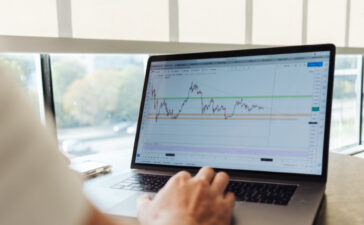Options trading is an ideal way to diversify your portfolio and grow your wealth, but you need a good strategy. So which is the best options strategy?
Most investors get into the options trading because it’s simple to understand. If you think that Amazon’s stock will go up, you can buy a call. If you believe that Amazon’s stock will go down, you can buy a put.
The best options strategy is one you can use anytime, offers a good return on investment, and limits your risk.
The vertical spread offers all three. In this article, we’ll explain the long vertical spread, how to use it, and how it limits risk when investing.
The Problem of Options Trading
It may sound strange to start an article talking about the problems inherent in options trading, but as you’ll see, it’s essential content to know. To understand how a vertical spread is the best options strategy, you must know why.
When most people start trading options, they will perform what is a naked option. That is when you buy a call or a put based on whether you think the stock will go up or down.
There are two problems with this:
- Time decay
- return on investment
When you buy a naked option, you’re hoping the stock will go up or down. However, to make a good return on investment, you often need to trust it will perform well in the direction you are hedging your bet.
With time decay, options become a depreciating asset. No smart investor will buy a depreciating asset and call it an investment. It is time decay, which makes options a depreciating asset. There is a better way.
The Best Options Strategy: Vertical Spread
The vertical spread is one of the best options strategies for new traders because it can save capital. It also eliminates time decay, making options an appreciating asset in most cases. Last, it has a good return on investment over making single calls or puts.
What Is a Vertical Spread?
A vertical spread is a long option and a short option purchased at different strike points but with the same expiration date. When you trade a vertical spread you’re trading two options at once.
However, we like to think of this as one trade, and it is a vertical spread. You can buy or sell a vertical spread as an opening trade. The reason it’s such a powerful trading opinion is that it has a high probability of success while also having minimal risk.
Let’s compare three scenarios when vertical options would be a good way to go over a single option.
Scenario 1
Let’s say that Amazon is selling for $75 per share to limit our risk. We are going to perform a vertical spread. We buy 70 strike call at $750 and sell the 80 strike call for $250. Our total investment is $500.
Had we only purchased the single call, we would have paid $750. Purchasing the vertical spread saved us $250 right from the start. That improves our breakeven on the trade.
Let’s say at the expiration date, the stock price has gone up to $79.50. The short 80 call we sold would now be worthless because it’s out of the money. So you made $250 on the short 80 call. The long call we bought for $7.50 is now worth $9.50, earning us $200. Our net profit is $450. That is a 90{7e0259aaa3060fed66852291a7d473d02e5444f60b251106bbd92dbe50858870} net return on investment.
Let’s compare this to the single call 70 option. We net a profit of $200, which comes out to a little over 26{7e0259aaa3060fed66852291a7d473d02e5444f60b251106bbd92dbe50858870}.
Scenario 2
Let’s say, instead of going up, the stock price has traded sideways, and at the end of the expiration date is $75. Our long 70 call would 5.00 resulting in a $250 loss on that leg of the trade. Our long 80 calls will be worthless because we are out of the money resulting in a profit of $250, so as you can see, the costs cancel each other out.
Compare that to our single long 70 call, and we have lost $250, a 33{7e0259aaa3060fed66852291a7d473d02e5444f60b251106bbd92dbe50858870} loss due to time decay. In the case of the vertical spread, time decay was not an issue whatsoever as we broke even.
Scenario 3
We are completely wrong about the price, and the stock goes down to $50 per share. Both of the options that make up our vertical spread are out of the money, and therefore worthless. We lose 750 on the long 70 call, but make $250 on our short 80 call. That gives us a return of 100{7e0259aaa3060fed66852291a7d473d02e5444f60b251106bbd92dbe50858870}.
Compare this to the single 70 strike call. We would have paid $750, and lost all of it, earning a 100{7e0259aaa3060fed66852291a7d473d02e5444f60b251106bbd92dbe50858870} loss—quite a difference. Buying the vertical was better than buying the single option in all three of these scenarios.
When Would the Single Call Win?
Let’s say the stock price soars to new heights and expires at $85. Our long 70 call we bought for $7.50 would now be worth $15. We would have earned $750 profit. On the short 80 call we would have lost $250, giving us a total profit of $500, or 100{7e0259aaa3060fed66852291a7d473d02e5444f60b251106bbd92dbe50858870}.
With our single call, we would have made $750 earning 100{7e0259aaa3060fed66852291a7d473d02e5444f60b251106bbd92dbe50858870} profit. In both cases, we are making 100{7e0259aaa3060fed66852291a7d473d02e5444f60b251106bbd92dbe50858870} profit, but the single call would have given more money.
Why Is Vertical Spread So Important?
The vertical spread is the most basic spread; however, it sets up the understanding for more complex spreads like the iron condor, butterfly, and the back ratio. That makes the vertical spread one of the best option trading tips you can use.
The Vertical Spread has a Higher Probability of Success and Less Risk
When it comes to finding the best options strategy, your best bet is the vertical spread. It ties into your learning of more options trading strategies, while also increasing our probability of success and lowering your risk.
If you’re looking for more information on how you can become a smarter investor, please look at our blog. We have tips to help.









